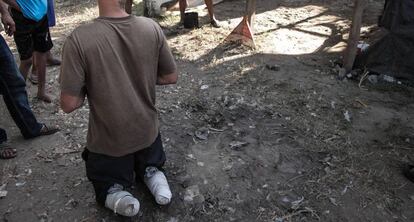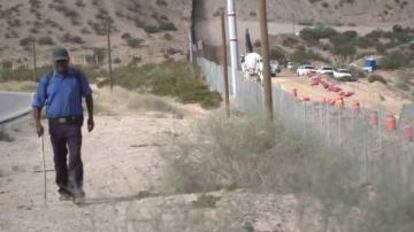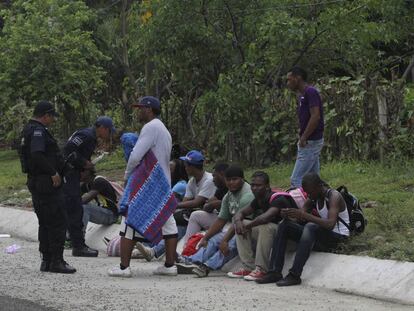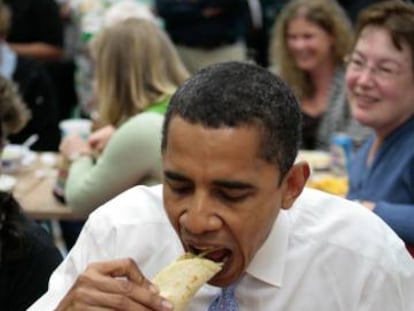Mexico’s other, invisible border wall
Following a migration deal with the US, deportations of Central Americans fleeing violence have soared

The border between Mexico and Guatemala stretches over 1,000 kilometers or so. The Suchiate River, which serves as a natural boundary along the southwestern part of this long frontier, can be crossed on foot when the water is low at a point located within the city limits of Tecún Umán. There are no questions asked, no papers required.

Standing near the river bank on the Guatemala side, Carla Ochoa serves beers while she puts up with rude remarks and lascivious looks from three drunks who have been here since 10am.
After attempting to reach the United States three times, giving birth to two children and getting raped once – by the police – Carla Ochoa no longer feels like crossing through Mexico again. Instead, she would rather serve beers right here in Tecún Umán.
This frontier town is teeming with salesmen, people smugglers, migrants, prostitutes, locals, currency exchangers and tuk-tuks. A few meters away from the crowds, Josué, a native of Honduras like Carla, drags himself along the ground on his leg stumps.
Mexico is doing the United States’ dirty work; that is what it was tasked with, and it is fulfilling its mission perfectly
Cristóbal Sánchez, immigration rights activist
“It was that son-of-a-bitch of a train,” says Josué about the accident that left him without legs six months ago, when he attempted to board La Bestia (The Beast), a freight train that runs south to north along the Gulf of Mexico.
“I grabbed the railroad car but I tripped and fell under the wheels. At first I didn’t even realize it, I didn’t feel any pain or anything, but when I tried to get up I saw both legs just lying there,” he says.
According to the Red Cross, 37 people lose a limb every year trying to board the northbound train.
Both Carla and Josué are now trapped on the other side of the invisible wall along Mexico’s southern border. Intense police surveillance, The Beast, drug cartels, people smugglers and deportations are the bricks holding together this virtual barrier located 3,000 kilometers south of the wall that Donald Trump intends to build.

“The wall that migrants fear is Mexico, it’s not the Trump wall,” explains Mario Hernani, coordinator of an immigrant center in Tecún Umán. “Everyone who undertakes the journey knows that they are going to be the victims of assault, extortion or rape, chiefly at the hands of the authorities.”
According to the Network of Migrant Defense Organizations (Redodem), which interviewed over 30,000 migrants staying at its shelters, nearly half of all crimes committed against them in 2015 were perpetrated by police officers (41%), followed by organized gangs and petty criminals.
Every year, around 400,000 people – mostly from Central America – transit through Mexico with less than $60 in their pockets, in a silent exodus of migrants fleeing the violence back home.
Marcelo, 36, and Nancy, 20, fled El Salvador on January 4 when an emissary from the infamous Mara Salvatrucha (MS) gang showed up at their door and gave them 24 hours to leave. It was the last warning. They wanted Nancy to start working for them.
The moment they crossed the river and set foot on Mexican territory, they were robbed of their money and cellphones.
Over 90% of Mexico's asylum requests came from individuals who hailed from the Central America’s Northern Triangle
“I left El Salvador out of fear, because the MS was going to rip me to shreds the following day, not because of the wall,” says Marcelo, sitting inside the courtyard of a migrant shelter. “I don’t know whether there will be a wall or not, but I had to get out of there fast.”
In contrast with the “pull factor” often cited in connection with illegal immigration, the United Nations High Commissioner for Refugees (UNHCR), shelter managers and other groups that work with migrants talk about something else: a humanitarian crisis.
In the last six years, asylum applications in Mexico have grown over 1,000%. From just a few hundreds cases in 2011, there were nearly 9,000 last year according to the UNHCR. And twice as many applications are expected next year.
Over 90% of those asylum requests came from individuals who hailed from Central America’s Northern Triangle, made up by Honduras, El Salvador and Guatemala. They were fleeing cities like San Salvador (El Salvador) and San Pedro Sula (Honduras), which rank as some of the most violent places in the world. The UN agency compares the current situation with the Central American exodus during the 1980s wars.

Mexico’s response has been to beef up the budget to arrest migrants and refugees through a program called Plan Frontera Sur, the southern border plan, which was signed in 2014 as part of a joint effort with the US. Since then, the number of arrests and deportations has soared.
Barack Obama was the US president that sent back the most migrants: 2,8 million between 2008 and 2016. But Mexico has taken up its role as the patroller of the south, deporting an even higher number than the US in the last two years. In 2016, the American government deported 96,000 migrants, compared with 147,000 deportations by Mexico, or 293 a day, according to official figures.
But while the US mainly sends back migrants with a criminal record, very few of the migrants deported from Mexico had a rap sheet.
“Mexico is doing the United States’ dirty work; that is what it was tasked with, and it is fulfilling its mission perfectly,” says Cristóbal Sánchez, an immigrant rights activist based in Tapachula.
On the other hand, Mexico’s refugee acceptance rate is 64%, a high figure compared with other countries, and a reminder of the country’s generosity with Spaniards and Central Americans fleeing civil wars during the 20th century.
Marcelo and Nancy are waiting at the Belén shelter in Tapachula for their asylum applications to be processed before they set off on the road again. “I want to get to the United States, but if that is not possible I would be happy in Mexico,” says Marcelo. “But not in Tapachula, I’m scared here. They’ve called us pickpockets, kidnappers, criminals, gang members...”
The mayor of Tapachula, Neftalí del Toro (PRI), has not helped. Following January riots throughout Mexico over the rising price of gas, he accused migrants of looting, and stated that “Tapachula is contaminated by foreigners.”
NOTE: Some of the names in this story have been changed for security reasons.
English version by Susana Urra.
Tu suscripción se está usando en otro dispositivo
¿Quieres añadir otro usuario a tu suscripción?
Si continúas leyendo en este dispositivo, no se podrá leer en el otro.
FlechaTu suscripción se está usando en otro dispositivo y solo puedes acceder a EL PAÍS desde un dispositivo a la vez.
Si quieres compartir tu cuenta, cambia tu suscripción a la modalidad Premium, así podrás añadir otro usuario. Cada uno accederá con su propia cuenta de email, lo que os permitirá personalizar vuestra experiencia en EL PAÍS.
¿Tienes una suscripción de empresa? Accede aquí para contratar más cuentas.
En el caso de no saber quién está usando tu cuenta, te recomendamos cambiar tu contraseña aquí.
Si decides continuar compartiendo tu cuenta, este mensaje se mostrará en tu dispositivo y en el de la otra persona que está usando tu cuenta de forma indefinida, afectando a tu experiencia de lectura. Puedes consultar aquí los términos y condiciones de la suscripción digital.
More information
Archived In
Últimas noticias
Most viewed
- Sinaloa Cartel war is taking its toll on Los Chapitos
- Oona Chaplin: ‘I told James Cameron that I was living in a treehouse and starting a permaculture project with a friend’
- Reinhard Genzel, Nobel laureate in physics: ‘One-minute videos will never give you the truth’
- Why the price of coffee has skyrocketed: from Brazilian plantations to specialty coffee houses
- Silver prices are going crazy: This is what’s fueling the rally










































